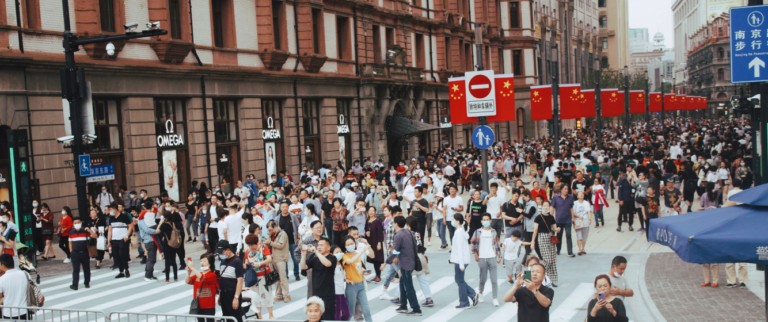On May 31st 2021, China announced the introduction of its third-child policy, concluding its previous two-child policy set in 2016. Facing a dwindling young labour force and rising elderly population, China’s third-child policy was implemented in hopes of reviving the country’s current demographic crisis, with last year leading to just 12 million babies born in a consecutive four-year birth rate decline. This number was the lowest for births on record since the 1960s.
Why China’s birth rate is declining
At present, China’s total fertility rate is 1.3 children per woman, which significantly trails behind the required 2.1 needed to counter China’s ageing population. The National Bureau of Statistics noted earlier in May that the average number of children Chinese women were willing to have in 2020 was 1.8.
The major deterrents for Chinese young couples regarding having more children are the lack of affordable childcare support, rising house prices and non-family friendly work hours clouded by a pervasive overtime culture.
In a March survey on millennials conducted by the Social Survey Centre of China Youth Daily, 67.3% of responders confessed that the incapacity to find domestic help was the number one reason they were reluctant to have a second child. Another 61.7% blamed financial limitations, 54% on lack of secure and suitable nurseries, 41.6% on higher demand for housing and finally 24.3% on the effect of the woman’s career.
Xinhua, China’s state news agency, reported that out of the 47 million children under 4 years old in China, only 5% are using day care services. These services are not only low in availability, but expensive, as more than 80% charge above government-guided pricing. Additionally, fierce competition in education lead to families moving to districts with good schools such as Beijing’s Haidian, where housing costs on average 90,000 yuan per square meter. According to a 2019 Shanghai Academy of Social Sciences report, low-income families in Shanghai’s Jingan and Minhang districts of annual incomes under 50,000 yuan spend over 70% of their earnings on their child. Even before the child is born, the costs are dear; resources are small in public hospitals so wealthier women turn to private clinics, often paying more than 100,000 RMB for prenatal tests and delivery.
How China’s birth rate crisis is affecting its economy and society
A shrinking labour force could significantly slow down China’s economy, which has heavily relied on its human capital in the past to become the manufacturing powerhouse it is today. According to Alberto Vettoretti, Managing Partner at Dezan Shira & Associates, “Factories are already under a very tight labour supply, while many processes cannot be fully automated. One of the most challenging aspects of running a factory in the Greater Bay Area nowadays is the availability of labour, triggering an increase in wages in order to attract or retain workers.” If Chinese factories are unable to find enough human labour, they may have to turn to the development of technological solutions to fulfil output expectations.
Yet this may prove to be a harder challenge. Another industry which can experience slow down of talented young labour talent is technology innovation, an area which is central to driving China’s economy in its 14th Five-Year Plan (2021-2025). Vettoretti holds a pessimistic view of China’s technological future. “A falling population, especially a declining young population in the 20-40 years of age bracket, may cause a decline in innovation and hunger to push China into the leading technological role it aspires to reach over the next decade. With technology playing such an important role in shaping our future, a tech-savvy, dynamic, and young talent pool is need to achieve these goals.”
Problems of China’s ageing population
Further, care for China’s ageing population is an added mounting issue; government researchers have warned that China’s pensions fund could become insolvent by 2035. In a country with a weak social insurance system, China’s economy may see lower saving rates in the future as more seniors will have to draw on their savings to fund their healthcare in China and support themselves after retirement. The 1980 one-child policy which lasted for 35 years has led to a ‘4-2-1’ problem where one person’s income needs to support up to 2 parents and 4 grandparents. In a country projected to have “over 300 million [people aged over sixty] by 2030”, the demand for affordable senior healthcare in China will rise as young Chinese tackle this financial burden.

China’s birth rate crisis needs more than the third-child policy
China’s third-child policy alone is not enough to resolve its dwindling birth rate. In a since deleted online poll from Xinhua, 29,000 respondents out of 31,000 answered that they would not consider having more children despite the third-child policy. Beijing has recognized that reducing education costs, improving maternity leave and increasing support services for the retired are all vital measures needed in conjunction.
Education is becoming more affordable
In its 14th Five-Year Plan made public in November last year, China vowed to reduce the cost of childbirth, parenting and education, starting with a crackdown on the expensive and booming private tutoring industry. In an official WeChat notice earlier last month, the Beijing Municipal Commission of Education announced it would establish free and discounted services for primary school students, to include study centres and libraries, as well as offering summer holiday sports activities. They have also subsidized private kindergartens in order to bring down fees which would help private kindergartens attract lower income families.
The childcare market in China is expanding
The preschool or childcare market in China will grow by 57.59 million USD by 2025. Yu Xiejun, deputy head of the National Health Commission, has pledged to improve on making childcare more universally available across the nation. This includes increasing the availability by 150% so that there would be 6.3 million spots across the country. Concrete plans are already underway in Shanghai, with the city set to open 543 more childcare centres and recruit 12,000 volunteers to assist these centres. The childcare market in China is one where demand overpowers supply; but while it will be easy attracting clients to enrol in a centre, businesses looking to distinguish themselves in this field will need to consider higher quality management and trained staff in order to increase appeal.
Family planning may become more inclusive
The 14th Five-Year Plan also emphasises on the ‘inclusiveness’ in the family planning policy for the first time, sparking debate over whether fertility policies would be extended fully to unmarried mothers and same-sex couples. Zhou Haiwang, demographer and deputy director of Institute of Population and Development under Shanghai Academy of Social Sciences, estimates that these ‘inclusive’ family polices are likely to include out-of-wedlock births, children per family restrictions and egg freezing limits. However, reforms are likely to take some time given conservative preferences. Zhai Zhenwu, chairman of the standing council of the China Population Association under the National Health and Family Planning Commission, stated fertility policies would be unlikely to extend to the LGBTQ community and unmarried couples for the next five years.
Workers’ rights may improve
On the burdens and pressures of young people’s careers front, China does have laws and policies which protect workers and female work rights. For example, the current labour law formally stipulates daily working hours do not exceed 8 hours and permits 36 hours of overtime per month and paid maternity leave can go up to 98 days nationally. The law also bans gender and pregnancy-based discrimination in employment.
However, in many cases these laws and policies are not followed due to lack of strong enforcement. The struggle to maintain good careers lead to workers overworking in a 996 work culture, a prevalent issue nationwide but most notable in the competitive technology sector which caters to China’s lazy economy phenomenon. Similarly, numerous women have told of their experiences in being forced to sign contracts agreeing not to get pregnant, or being demoted or fired once they do. Better measurements are still needed to protect worker and female employment rights.
China’s elderly care market will grow
Lastly, China’s elderly care services has improved and increased over the last two decades. Elderly care service institutions increased from 150,000 in 2017 to nearly 220,000 in summer 2020. The country has also eradicated the demands of educational background in the elderly care personnel sector as a strategy to employ more care workers. By the end of 2022, Beijing aims to train 10,000 new nursing home directors 100,000 new part- or full-time social workers.
Further to this, China adopts a ‘90/7/3’ scheme for its senior citizens: 90% of retirees live with family at home, 7% visit community centres and 3% stay in private care homes. To support the ‘90/7/3’ scheme, the government funded 5 billion yuan from 2015 to 2020 to support pilot programmes centred around home-based and community-based elderly care services in 203 cities.
China needs at-home elderly care solutions
Since much of China’s elderly care policy is indeed weighted on at-home elderly care, businesses could seize this opportunity to build affordable at-home solutions. This would also be in synergy with the traditional views of filial piety in China, where Chinese people are expected to care for their parents as they age and sending elderly parents to a care facility is viewed as shameful.
A successful example of a Chinese home care service provider in China is Pinetree. Although Chinese home care services are often more expensive than industrialized elderly care, Pinetree has managed to become the country’s largest Chinese home care service provider due to its affordability. It has several key strategies. By capitalizing on a sharing economy, Pinetree improves its efficiency by hiring ‘contractor caregivers’, many who simultaneously work in hospitals and elderly homes, and providing them with the most optimized service routes.
In addition, Pinetree also remains efficient by using video conferences via an AI robot to connect the patient, family members and medical experts together, and can use its robots to calculate a priority list of the most relevant and hardest cases for the top experts. Finally, Pinetree’s focus on restorative care encourage patients to move and carry out activities by themselves, supporting the individual to exercise their capabilities and practise.

Incentives to boost China’s birth rate
In addition to tackling the pressures and stress of childbearing and raising children, Chinese provinces and cities have established their own rules and measurements to counter the China’s birth rate decline. Although not a direct pregnancy incentive, Northern Shanxi province announced in 2018 that it would provide a wedding subsidy, to include partial funding on wedding photoshoots, honeymoon holiday and even 5% on the wedding dress. In the province of Hubei, Xiantao city offers 1,200 yuan in monetary reward for a second child born. Meanwhile, Jiangsu province maintains a ‘fetus protection leave’ which allows women in their first trimester to take paid leave at 80% salary upon a note from the doctor; this comes in addition to the nationwide 98 days paid maternity leave.
However, Liang Jianzhang, a professor from Peking University’s School of Economics and founder of travel service provider Ctrip, has stated that it would take 1 million yuan per child born in order to bring China’s birth rate to the stable 2.1 level. This 1 million yuan could come in the form of cash rewards, tax waivers and housing grants. According to Liang, “if a family gives birth to another child, that child’s future contributions to social security, to tax revenues, will exceed 1 million yuan”.
“Baby bonus” – will it work?
Offering ‘Baby Bonus’ incentives is not a new solution to the world, with many countries in the past two decades engaging in their own versions. However, all of these other countries, with exception of France, have failed to revive the birth rate to the replacement level. Despite the financial incentives, more and more females are choosing their career over children, because they feel they can only choose one or the other. Failure of financial incentives could be the case for China too. However, it is important to note that, unlike most of these countries, China is a developing country with a significant wealth divide, and poorer Chinese citizens may seek refuge from the financial incentive and relief ‘Baby Bonus’ rewards.
Four key takeaways from China’s ageing population crisis:
- China’s third-child policy alone will not revive the decline in China’s birth rates, so the government is resorting to other methods to reduce the burden of having a child.
- China’s greying population are seeking good quality private care homes and Chinese home care services, so companies should focus on improving efficiency whilst also adhering to the Chinese traditional views on filial piety.
- Lower income families are demanding an affordable and accessible childcare market in China, so businesses looking to expand a nursery franchise should investigate how to minimize costs.
- Stronger enforcement and support for restricted working hours and female anti-discrimination may become a focus point within the next five years as China implements its 14th Five-Year Plan; if so, companies must adhere to these policies.
- Financial rewards as well as other beneficial incentives could encourage Chinese couples to have more children.





